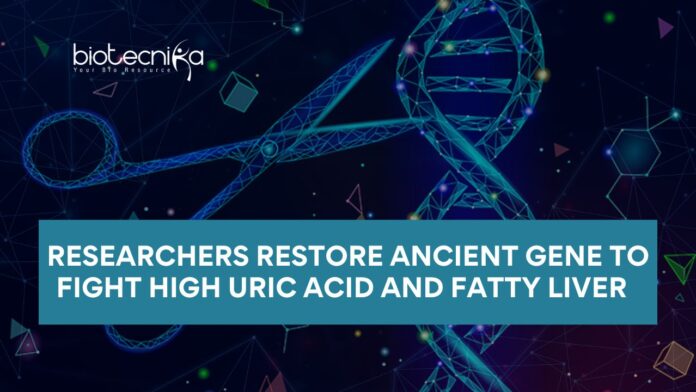CRISPR Cas9 Technology Revives the Lost Gene
Researchers at Georgia State University have reactivated an extinct gene that humans lost millions of years ago using CRISPR Cas9 technology. This gene codes for an enzyme that breaks down Uric Acid, further lowering its accumulation in the body. The study reveals that this approach leads to new treatment strategies for conditions like Gout and Fatty liver. Gout is the accumulation of excess uric acid that crystallizes in the joints, causing swelling and pain.
The Lost Gene for Uricase
Uricase, the enzyme that breaks down Uric Acid, a waste product. The enzyme is still functional in many mammals, but studies suggest that humans have lost this during the course of evolution, roughly around 20 – 30 million years ago. It means that modern humans cannot break down the uric acid easily, which escalates the accumulation in joints, kidneys, livers, and metabolic complications. A few scientists share that the elevated amount of uric acid might have helped the primates in the conversion of fruit sugars to fat during lean times, boosting their survival.
The Georgia State team, led by biology professor Eric Gaucher, aimed to test the potency of this gene when brought back into the system using CRISPR gene editing technology.
The Revival
Gaucher along with postdoctoral researcher Lais de Lima Balico, reconstructed and inserted into the liver cells the ancient gene using CRISPR Cas9 technology to study if it could make Uricase again, in the body. The results were striking. The edited liver cells started to break down the uric acid, and when exposed to fructose (fruit sugar), they did not accumulate fat, unlike normal human liver cells do. To understand further and check if it was limited to cell culture, they tested the edited gene on 3D liver spheroids. Spheroids are tiny lab-grown liver models that behave like a normal and regal tissue. It worked! The levels of uric acid dropped dramatically, and no fat deposition was observed. Additionally, the enzymes enter peroxisomes and other cell compartments where the natural enzyme operates. This suggests that the enzyme works naturally despite being extinct for ages, opening the door to new technologies.
This study not only serves as a new treatment approach for gout or fatty liver, but also for Hyperuricemia, a condition characterized by elevated uric acid levels. Studies say that hypertension and cardiovascular disease are linked with high uric acid levels, and there is a need to find a way to reduce the risks.
By restoring uricase, many related conditions can be prevented. Currently, the treatments for Gout are not effective for everyone, and some experience adverse reactions to the uricase-based medicines. For now, the Georgia State study opens a compelling new chapter in metabolic disease research one that literally rewinds the genetic clock to restore a once-lost enzyme and, potentially, a healthier future.























